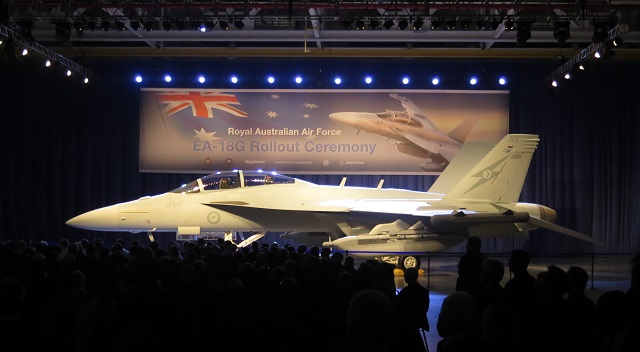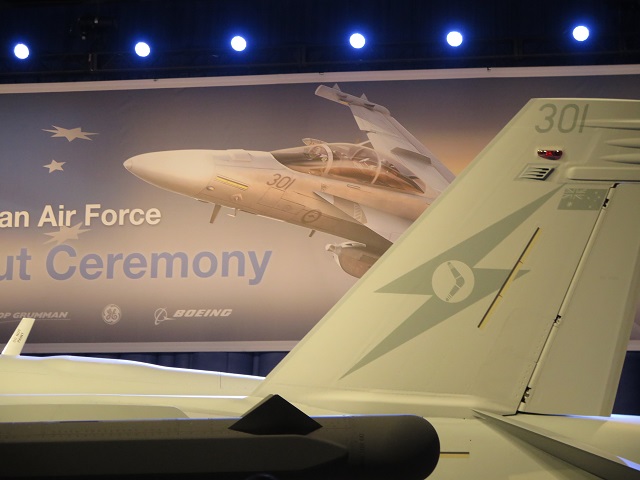Boeing has unveiled the first of 12 Australian EA-18G Growler electronic attack aircraft at a ceremony in St Louis, Missouri, and company officials say the second example is already flight testing.
Once the second aircraft delivers in August, the two examples will be delivered to Naval Air Weapons Station China Lake where Australian pilots are currently training with their US Navy counterparts. Those aircraft will also visit the US Navy’s home of airborne electronic warfare at Naval Air Station Whidbey in 2016 before moving Down Under in 2017.
Delivery of the first aircraft, tail number A46-301, is a significant milestone for the Royal Australia Air Force (RAAF), which will soon be able to shut down enemy surface-to-air missile, radars, electronic transmissions, communications equipment across a wide area.
“It really does decrease the risk to all operations whether you’re flying a C-17, P-8, Super Hornet or F-35,” says former RAAF chief Air Marshal Geoffrey Brown, who attended the 29 July rollout ceremony. “It is truly a unique capability, critical to our future operations.”
Daniel Gillian, Boeing Defense, Space & Security’s vice-president of F/A-18 and EA-18G programmes, says the Aussie Growler entered flight testing 13 July and the second aircraft is fully assembled and flying. He says it is the 116th Growler delivered to date out of a 165-aircraft programme of record for the Navy and RAAF.

Flightglobal
Brown says that unlike the US Navy aircraft, Australia’s Growlers will carry Raytheon Advanced Targeting Forward Looking Infrared (ATFLR) pods and AIM-9X Sidewinders. He says those capabilities were added as a direct result of the US Growler’s operational experience in Libya as part of Operation Odyssey Dawn.
The air marshal says the Australian jets will also someday carry the US Navy’s Next-Generation Jammer, which is in development to replace the current ALQ-99 Tactical Jamming System.
“Our time line will be the same as the US Navy,” says Brown. “As the US Navy upgrades this airplane, we’ll stay lock-step.”
Brown says the Growler is the most impactful new capability since the introduction of the General Dynamics F-111 in the 1970s.
“It’s such a big change, and it gives us so many more options than we’ve ever had before. Never have we had the ability to attack the electronic spectrum the way this airplane will do,” he says.
The Growler will be Australia’s sixth in-service Boeing type after the E-7A Wedgetail, C-17 Globemaster, CH-47F Chinook and F/A-18 Hornet and Super Hornet.
Brown says the Classic Hornet celebrated its 30th anniversary this year and is “still going as hard as the day it was built”. Australian Classic Hornets and Super Hornets are currently supporting the US-led air campaign against Islamic State militant in Iraq and are flying at four times the peacetime rate. “It’s an ugly, reliable aircraft. It’s bulletproof,” he says.
Australia is buying 36 Super Hornets, 12 of which are twin-seat Growlers.
The delivery comes as Australian pilots train on RAAF’s first Lockheed Martin F-35A Joint Strike Fighters at Luke AFB in Arizona.
It also comes amid uncertainty over the future of the Boeing Super Hornet production line in St Louis.
Gillian says Boeing has decided to keep the mixed-model line going at a rate of two aircraft per month starting in the first quarter of 2016. The rate was four per month last year and has already gone down to three as existing orders are delivered.
The current Growler programme is expected to wrap up in December 2017, but a Navy order for 12 more Super Hornets and 24-36 orders from an unnamed “Middle East customer” – reportedly Kuwait – would keep the line going through 2019 or 2020.
“The momentum is behind the Super Hornet and we see that holding up,” Gillian says. “We’re seeing enough demand signals from the market to make a decision to move forward with production.”

Flightglobal
Source: FlightGlobal.com



















